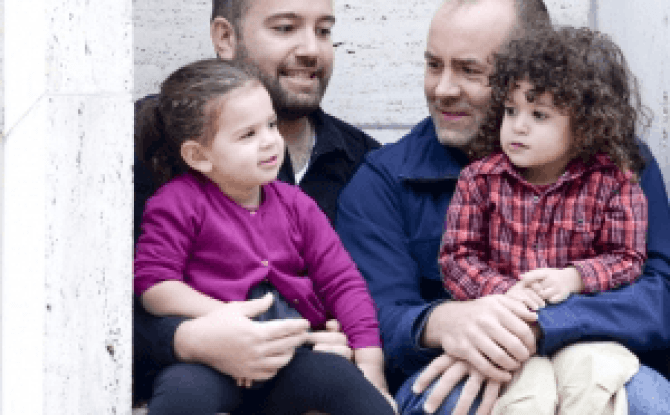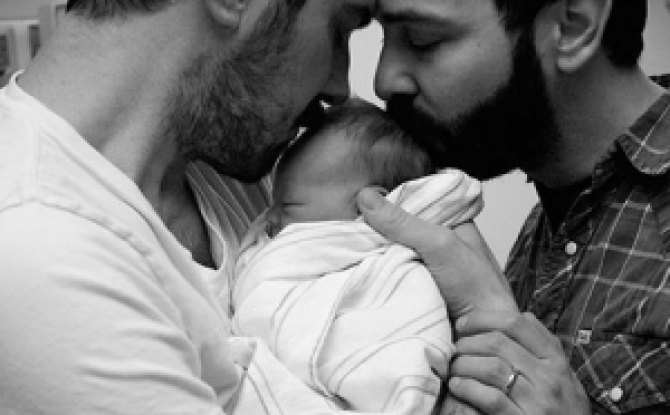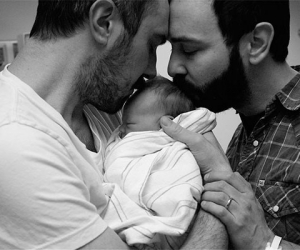MyKwartha.com, March 20, 2015 – By Andrea Gordon
Baby Jasmine Chan delivered the ultimate Valentine’s Day gift to her parents this year. It was her first word, clear and deliberate.
“Daddy,” she said, beaming across the dinner table.
Music to her two dads’ ears.
When they met 12 years ago, Paul Chan and Ewan French never imagined they would one day answer to Daddy or Papa.
Chan had recently come out to his family. It was a tough period and his mother was heartbroken. She wanted grandkids. He assumed his own dream of being a father would never come true.
It wasn’t until they married two years ago that the couple started to explore the idea of parenthood. Chan, 33, was confident they could be good, loving parents. French was on the fence.
“I always knew we’d have a strong community around us,” says French, 34, who was born and raised in Scotland.
“But I didn’t want (our child) to face any challenges because of having same-sex parents. Would we be putting her at an unfair advantage because of it?”
According to a new book from University of Cambridge developmental psychologist Susan Golombok, the answer is a resounding “No.”
Golombok, director of the university’s Centre for Family Research, has been studying the impact of evolving family structures on children for almost 40 years.
Modern Families: Parents and Children in New Family Forms, which rounds up research from around the world, concludes that children raised by same-sex parents and solo moms by choice or born as a result of donor conception or surrogacy fare just as well as kids raised by a two-parent, heterosexual married couple.
“The main conclusion is that what matters for children is not so much the structure of the family — the gender or sexual orientation of their parents, the number of parents or whether parents are biologically related to their children,” Golombok said in a phone interview from England.
“What seems to be more important is the quality of the relationships within the family.”
In other words, while the traditional model of mom, dad and biological kids was once considered “the gold standard,” four decades of research doesn’t bear that out.
All other things being equal, children manage just as well — and face the same difficulties — whether they have two dads and no mom, or two moms and no father as they do with two heterosexual parents. There is no evidence they have more psychological problems, difficulty adjusting or atypical gender development, Golombok found.
The fluidity of partnerships and family is also the subject of a soon-to-be-released book by Hollywood actress Maria Bello.
Her memoir, Whatever…Love is Love, follows her 2013 Modern Love column in the Sunday New York Times, which drew accolades. Titled “Coming Out as a Modern Family,” it told the poignant story of how Bello explained to her 12-year-old son that she was in love with her best friend, a woman.
The piece, which made the list of the top 10 Modern Love columns ever written, highlights the resilience and adaptability that kids can demonstrate when they have trusting relationships with parents.
It’s something Chantal Saville has seen in her 6-year-old daughter Nikki, who she’s now raising with the help of her own mom.
After Saville’s marriage broke up two years ago and the couple sold the business they ran outside Peterborough, she wondered how she’d make ends meet.
Her mother, widowed a decade earlier, was still living in the Toronto bungalow Saville grew up in as an only child. The two had always been close.
“Now we are effectively co-parenting Nikki,” says Saville, 42, a writer.
In the early days, mom and grandma occasionally locked horns over discipline when the era of, “because I said so” clashed with modern refrain of, “sweetie, here’s why I need you to do what I ask.”
But they’ve learned that communication is key and that whoever is in charge at a given moment gets the final word.
Organizations like American Academy of Pediatrics and the American Psychological Association have already endorsed findings that the sexual orientation of parents has no bearing on child-rearing abilities or the well-being of kids.
What’s new about Modern Families is it brings together empirical research involving many thousands of families from around the world and explores some of the reasons that more unorthodox families seem to do so well.
Golombok’s career has spanned an evolution in family life, starting in the late 1970s as lesbian moms came out and divorced husbands fought for the right to raise their children, followed by the arrival of the first test-tube baby in 1978.
The book comes amid a huge shift in how society recognizes and accommodates the assortment of families created as a result of assisted reproductive technologies. Modern kids may have a “solo mom” who chose to have a child on her own using donated sperm, or relationships with as many as five parents, including two legal parents, a sperm donor, egg donor and a surrogate.
The careful planning and lengths these parents go to in order to have children may be one reason their kids do well, says Golombok.
It can require years of fertility treatment and facing other barriers like social disapproval. The less motivated give up along the way.
Click here to read the entire article.


 This is the story of Baby Love. Baby Love isn’t her real name; it is the name we chose for the purposes of this story. One reason we are going to call her Baby Love is that her parents would like to give her a choice when she grows up to keep this story to herself. More to the point, we are calling her Baby Love because three people took every ounce of their love, from the far corners of New York to the depths of Texas, to bring Baby Love into this world. If you stick with the story, you will hear about the moment Baby Love was born.
This is the story of Baby Love. Baby Love isn’t her real name; it is the name we chose for the purposes of this story. One reason we are going to call her Baby Love is that her parents would like to give her a choice when she grows up to keep this story to herself. More to the point, we are calling her Baby Love because three people took every ounce of their love, from the far corners of New York to the depths of Texas, to bring Baby Love into this world. If you stick with the story, you will hear about the moment Baby Love was born.





 Fifth grader Zoe, at her blog Kids’ Animal Station, has written
Fifth grader Zoe, at her blog Kids’ Animal Station, has written